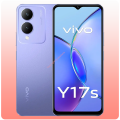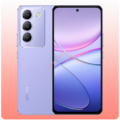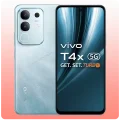- Home
- All Products
- Mobiles
- vivo T4
vivo T4





-
CPU: Snapdragon 7s Gen 3 (4 nm)
-
RAM: 12GB, 16GB
-
Storage: 256GB, 512GB, 1TB - UFS 4.1
-
Display: LTPO AMOLED, 1B colors, 120Hz
-
Main Camera: 50 MP + 200 MP + 50 MP
-
Selfie Camera: 50 MP
-
Battery: Si/C Li-Ion 6000 mAh
-
OS: Android 15, OriginOS 5
Overview
General
| Device Type | Smart Phone |
| Announced | 21-04-2025 |
| Released | 29-04-2025 |
| Status | Available |
| International Price | $1,146 |
| Indian Price | ₹75,500 |
| BD Unofficial Price | ৳133,000 |
Design
| Type Design Type called form factor refers to a mobile phone's size, shape, and style as well as the layout and position of major components of phone. There are three major form factors seen in mobile phones => bar phones, folding phones and sliding phones. | Bar |
| Dimensions | 163.1 x 76.8 x 8.7 mm (6.42 x 3.02 x 0.34 in) |
| Weight | 229 g or 232 g (8.08 oz) |
| Body Thickness | 8.7mm |
| Protection | Glass front, glass back, aluminum frame |
| Colors | Black, Silver, Red |
| Water Resistant | IP69/IP68 dust tight and water resistant (immersible up to 1.5m for 30 min) |
Network
| Technology | GSM / CDMA / HSPA / LTE / 5G |
| SIM | Nano-SIM + Nano-SIM |
| Speed | HSPA, LTE, 5G |
Display
| Display Type Display Technology => A number of display technologies and types used in mobile phones => TFT (Thin Film Transistor), IPS (In-Place Switching), OLED (Organic Light Emitting Diode), AMOLED (Active-Matrix Organic Light-Emitting Diode), Super AMOLED (an even advanced version of AMOLED), Resistive Touchscreen (Resistive touchscreens contain two layer of conductive material with a very small gap between them which acts as a resistance), Capacitive Touchsceen (Capacitive touchscreen technology consists of a layer of glass coated with a transparent conductor) | LTPO AMOLED, Dolby Vision, HDR Vivid |
| Size | 6.82 inches, 113.0 cm2 (~90.2% screen-to-body ratio) |
| Resolution | 1440 x 3168 pixels |
| Display Colors Display Colors is refers to the number of different shades of colors that the screen is capable of displaying => 64K colors, 256K colors and 16 million colors, Obviously 16M is highest available range of colors and better than others. | 1B colors |
| Pixel Density Pixel Density (PPI) is refers to the concentration of pixels on a particular display, measured in pixels per inch (ppi). Pixel density is calculated by dividing the diagonal pixel resolution of a display by its diagonal size, higher pixel density better display quality. | (~510 ppi density) |
| Refresh Rate | 120Hz |
| Display Protection Display Protection => Gorilla Glass is a special alkali-aluminosilicate glass shield with exceptional damage resistance that helps protect mobile displays from scratches, drops, and bumps of everyday use, It is always better to go for a smartphone with Gorilla Glass for that added protection and peace of mind. | Armor glass |
| Display Brightness | 4500 nits (peak) |
Main Camera
| Camera 1 Camera is able to capture photographs and usually videos, The most important characteristics of a camera are the resolution (measured in megapixels), lens focus type (fixed or automatic), higher megapixel cameras are known to capture higher quality photos, but not always a good measurement of the photos quality. | 50 MP, f/1.7, 35mm (wide), 1/1.28", 1.22µm, dual pixel PDAF, gimbal OIS |
| Camera 2 | 200 MP, f/2.3, 85mm (periscope telephoto), 1/1.4", 0.56µm, multi-directional PDAF, OIS, 3.7x optical zoom, macro 3.4:1 |
| Camera 3 | 50 MP, f/2.0, 14mm, 116˚ (ultrawide), 1/1.28", 1.22µm, dual pixel PDAF, OIS |
| Video | 8K@30fps, 4K@30/60/120fps, 1080p@30/60/120/240fps, gyro-EIS, Dolby Vision HDR, 10-bit Log, HDR10+ |
| Camera Features | Laser AF, color spectrum sensor, Zeiss optics, Zeiss T* lens coating, LED flash, panorama, HDR, 3D LUT import |
Selfie Camera
| Camera 1 Camera is able to capture photographs and usually videos, The most important characteristics of a camera are the resolution (measured in megapixels), lens focus type (fixed or automatic), higher megapixel cameras are known to capture higher quality photos, but not always a good measurement of the photos quality. | 50 MP, f/2.5, 24mm (wide), 1/2.76", 0.64µm, AF |
| Camera Features | HDR |
Software
| Operating System OS => Every computer system run on a base software called Operating System (OS). Operating System controls all basic operations of the computer (such as smartphone, PDAs, tablet computers and other handheld devices). The Operating System allows the user to install and run third party applications (apps), apps are used to add new functionality to the device. | Android 15 |
| User Interface UI or user interface of a device is the look and feel of the on-screen menu system. How it works, its color scheme, how it responds to button presses, all of these things are part of the user interface. | OriginOS 5 |
Hardware
| Chipset Chipset is a group of integrated circuits designed to perform one or a more dedicated functions, often with real time computing constraints, Popular smartphones are equipped with more advanced embedded chipsets that can do many different tasks depending on their programming. | Qualcomm SM8750-AB Snapdragon 8 Elite (3 nm) |
| CPU CPU (Central Processing Unit) mostly known as processors, CPU processes instructions in order to carry out certain functions that make your device operate properly. Processors are often described as the brain of computers, smartphones and tablets, Smartphones and tablets rely on processors to carry out their every task, Processors are an incredibly important factor in selecting any type of computing device, including your smartphone. |
Octa-core (2x4.32 GHz Oryon V2 Phoenix L + 6x3.53 GHz Oryon V2 Phoenix M) |
| GPU GPU (Graphics Processing Unit) is a single-chip processor designed to rapidly manipulate and alter memory to accelerate the creation of images in a frame buffer intended for output to a display, This includes things such as lighting effects, object transformations, and 3D motion. | Adreno 830 |
| RAM (Memory) RAM (Random Access Memory) is a type of computer memory that can be accessed randomly, any byte of memory can be accessed without touching the preceding bytes that allows information to be stored and accessed quickly from random locations. RAM is the most common type of memory found in computer systems, smartphones, tablets and other electronic devices. | 12GB, 16GB |
| Internal Storage Internal Storage is a data storage space (flash memory) mostly used in smartphones, tablets and other electronic devices where operating system, apps, music, photos, videos, files and other user data Is stored. | 256GB , 512GB , 1TB |
| Storage Technology | UFS 4.1 |
| Card Slot Memory Card Slot is a special slot for inserting a memory card. Memory cards allow you to expand the phone's built-in memory, A memory card (sometimes called a flash memory card or a storage card) is a small storage medium used to store data such as text, pictures, audio, and video, for use on small, portable or remote computing devices such as mobile phones, mp3 players, digital cameras. | No |
| Sensors Sensors are electronic components that detects and responds to some type of input from the physical environment. The specific input could be light, heat, motion, moisture, pressure and location, The output is generally a signal that is converted to use in computing systems, a location sensor, such as a GPS receiver is able to detect current location of your electronic device. |
Fingerprint (under display, ultrasonic), accelerometer, gyro, proximity, compass Emergency SOS via satellite (calls, messages) - 16GB + 1TB model only |
Connectivity
| Bluetooth Bluetooth is a wireless communications technology for exchanging data between mobile phones, headsets, computers and other network devices over short distances without wires, Bluetooth technology was primarily designed to support simple wireless networking of personal consumer devices. | 5.4, A2DP, LE, aptX HD, aptX Adaptive, aptX Lossless, LHDC 5 |
| Wi-fi Wi-Fi is a popular wireless networking technology using radio waves to provide high-speed network connections that allows devices to communicate without cords or cables, Wi-Fi is increasingly becoming the preferred mode of internet connectivity all over the world. | Wi-Fi 802.11 a/b/g/n/ac/6/7, dual-band |
| USB | USB Type-C 3.2, OTG, DisplayPort |
| Placement GPS The Global Positioning System is a satellite-based radio navigation system, GPS permits users to determine their position, velocity and the time 24 hours a day, in all weather, anywhere in the world, In order to locate your position, your device or GPS receiver must have a clear view of the sky. | GPS (L1+L5), BDS (B1I+B1c+B2a), GALILEO (E1+E5a), QZSS (L1+L5), GLONASS |
| NFC NFC (Near field communication) is a set of standards for smartphones and similar devices to establish peer-to-peer radio communications with each other by touching them together or bringing them into proximity, usually no more than a few inches. | Yes |
| Wireless Charging Wireless Charging (Inductive Charging) uses an electromagnetic field to transfer energy between two objects. This is usually done with a charging station. Energy is sent through an inductive coupling to an electrical device, which can then use that energy to charge batteries or run the device. |
Sound
| Loudspeaker | Yes, with stereo speakers |
| Headphone Jack |
Battery
| Battery Type Battery Type => Cell phones run on various kinds of batteries depending on the manufacturer, phone size or shape and features. There are basically four types of cell phone batteries => Lithium Polymer, Lithium Ion, Nickel Metal Hydride and Nickel Cadmium. | Si-Ca (Silicon Carbide) |
| Capacity Battery Capacity is a measure (typically in Amp-hr) of the charge stored by the battery, and is determined by the mass of active material contained in the battery. The battery capacity represents the maximum amount of energy that can be extracted from the battery under certain conditions. | 6000 mAh |
| Charging |
90W wired, PD, PPS, QC, UFCS 40W wireless Reverse wired Reverse wireless |
Performance Tests
| AnTuTu | 2,718,159 |
| GeekBench |
Single-Core: 2,979 Multi-Core: 9,353 |
Overall Review
The Vivo X200 Ultra is a flagship smartphone that redefines mobile photography and performance, positioning itself as a formidable contender in the premium smartphone market.
📸 Camera Capabilities
At the heart of the X200 Ultra is its advanced triple rear camera system:
- 50MP Ultra-Wide Lens: 14mm f/2.0, ideal for expansive landscape shots.
- 50MP Standard Wide Lens: 35mm f/1.69, perfect for portraits with natural depth.
- 200MP Telephoto Lens: 85mm f/2.27, featuring Samsung’s ISOCELL HP9 sensor, offering up to 3.7x optical zoom and macro capabilities.
All lenses are equipped with Optical Image Stabilization (OIS) and can capture 10-bit 4K video at 60fps, with slow-motion support up to 4K at 120fps. The device also incorporates Vivo’s custom VS1 and V3+ image processing chips to enhance RAW data handling and post-processing tasks.
⚙️ Performance & Hardware
- Processor: Qualcomm Snapdragon 8 Elite, ensuring top-tier performance.
- Memory & Storage: Up to 16GB RAM and 1TB UFS 4.0 storage, catering to power users.
- Display: 6.82-inch OLED with under-display fingerprint sensor, delivering vibrant visuals.
- Battery: 6,000mAh capacity with 90W wired and up to 40W wireless charging, ensuring prolonged usage.
- Build: Available in silver, red, and black, with an IP68 rating for dust and water resistance.
🎥 Photographer Kit
For photography enthusiasts, Vivo offers an optional Photographer Kit:
- Ergonomic Grip: Includes a dedicated video record button and customizable settings dial.
- Zoom Control: Facilitates precise zoom adjustments.
- Additional Battery: An extra 2,300mAh battery extends the device’s usage time.
- Zeiss 2.35x Telephoto Lens: Enhances optical zoom capabilities up to 8.7x.
📱 Software & Features
- Operating System: Android 15 with Vivo’s OriginOS 5, offering a clean and intuitive user experience.
- Customizable Shutter Button: Allows for exposure and zoom adjustments via touch gestures.
- Advanced Connectivity: Supports 5G, Wi-Fi 7, Bluetooth 5.4, and NFC.
✅ Pros
- Exceptional Camera System: Rivals professional cameras in versatility and quality.
- Robust Performance: Handles demanding tasks with ease.
- Long Battery Life: Ensures extended usage without frequent charging.
- Innovative Accessories: Photographer Kit enhances the mobile photography experience.
⚠️ Cons
- Limited Global Availability: Currently launched in China, with no confirmed international release.
- Size & Weight: The device, especially with the Photographer Kit, may be bulky for some users.
🎯 Conclusion
The Vivo X200 Ultra stands out as a powerhouse in mobile photography, offering features that appeal to both professional photographers and tech enthusiasts. Its combination of advanced camera technology, high-performance hardware, and innovative accessories positions it as a top-tier choice for those seeking the best in smartphone capabilities.
Disclaimer Note
Disclaimer: Prices listed are for reference only and may vary. We strive to keep information up to date but cannot guarantee accuracy. Please verify with the retailer before making a purchase.






